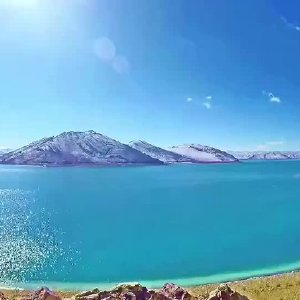The Sakyamuni Buddha Statue in Jokhang Temple
@catherine Housed in the central Buddha Hall, the seated Jowo Rinpoche is 1.5 meters high, has a vivid shape and a peaceful expression, holding a bowl in the left hand and putting the right hand on the lap. With a benevolent and silent smile, he seems to be comforting all living beings in gentle words.
The Tibetan people set the Buddha Shakyamuni
statue with many gems, such as turquoise, red coral, pearls, amber, jade beads,
etc. The most striking is the three "nine-eye" Dzi beads mounted on
the crown. The overall design of these gems is rigorous and solemn. The superb
casting and inlay process, representing the culture and art of Tibetan religion,
make this precious Buddha statue of Sakyamuni more brilliant and beautiful.
After the largest renovation and expansion in history, in 1409, the founder of the Gelug school of Tibetan Buddhism, Tsongkhapa put on a Five-Buddha Crown(Buddhist hats) for it.
Shakyamuni statue has also been damaged along with the Jokhang Temple during the Cultural Revolution and both were later restored.
Jowo Shakyamuni is the most revered god
enshrined in the Jokhang Temple, the essence of Tibetan Buddhism, and the
center of the spiritual universe for millions of Buddhist believers. The pilgrims of
Tibetan Buddhism believes in Jowo Shakyamuni and regards it as the greatest
spiritual belief. They admire it the most. Generally speaking, most temples
enshrine Shakyamuni’s statue of all kinds. What is so special about this one? Not
only because it has high value as a historical relic, but also because the
sacred and rare origin feels like the presence of the Buddha.
When Shakyamuni was alive, his disciples
asked craftsmen to make three statues for him, which were 8 years old, 12 years
old, and 25 years old (or 30) respectively. With the guidance of his mammy, the
statues are very much like the Buddha himself. After the statues were finished,
Shakyamuni himself opened of light for the statues and scattered the flowers
for blessings.
Among the three statues, the gilt bronze statue of the 12-year-old is the noblest and most exquisite. It is said that anyone who sees the Buddha Shakyamuni statue will have all the merits of Seeing, Hearing, Thinking, and Touching, then be able to free himself from the three roots of suffering and achieve liberation from Samsara in the future, which is exactly the same as that of seeing the Buddha of 2500 years ago, without any slightest difference.
In the heart of every devout Tibetan, there is the same wish that to worship Jowo Rinpoche enshrined in the Jokhang Temple. Tibetans prostrate all the way to the destination, hoping to accumulate merits and free from the cycle of rebirth. Devotees pay their respects to the Buddha in various ways. At every Buddhist festival, locals will come to worship the Buddha of Jokhang Temple. They circle around the statue of Shakyamuni Buddha, moving slowly. The stream of people flows endlessly through the kora path and never stops. For centuries, pilgrims prostrate in front of the Jokhang Temple one after another, even its rough stone slab has been rubbed as smooth as a mirror. Devotees offer butter for the ever-burning lamps, present Khata at the Shrine, or repaint the Buddha statue with gold powder. In short, they dedicated all their respects to the Buddha. A few very faithful pilgrims use a rare way to worship the Buddha. They kneel down and touch the head on the ground one step at a time, practicing all the way from all over Tibet outside Lhasa, even from Qinghai, Sichuan, and Gansu Tibetan areas to Jokhang Temple, as if measuring the highland with their bodies. In the end, they kneel down at the feet of the Buddha, leaning on his left knee, and whisper prayers and wishes. This should be the happiest and most satisfying moment for Tibetan Buddhists. No wonder you can see crowds of pilgrims every day around the Jokhang Monastery.
There is a version about how Jowo Shakyamuni being able to come to Lhasa. The 25-year-old Buddha statue sank into the Indian Ocean due to religious wars in India. According to Tibetan literature, an Indian king of Magadha presented the 12-year-old Jowo statue to the emporer Fu Jian (337–385) of Former Qin during the Chinese Sixteen Kingdoms period, in order to thank him for his assistance in defeating invaders and re-spreading Buddhism. When Songtsen Gampo married the Chinese princess Wencheng, Emperor Taizong (598-649) gave the statue to Princess Wencheng as a dowry. And Jowo Shakyamuni was carried to Tibet in 641 and enshrined in the Jokhang Temple. Since then, the Shakyamuni statue has shared glory and disgrace with Tibetan Buddhism.
Jowo Rinpoche is the reason Jokhang Temple took the spiritual center, and it can even be said to be the reason why Lhasa became a capital city. During the Songtsen Gampo period, the construction of Jokhang Temple was undoubtedly a very grand project. The infrastructure construction alone took three years. After expansion several times throughout the ages, it reaches the current scale. The old Barkhor Street was simply a pilgrimage road around the Jokhang Temple. When more people came to worship, hotels, restaurants, shops, etc. appeared one after another, and a bustling commercial center slowly formed. From this, a prosperous Lhasa city formed.
The Nepalese Princess Bhrikuti carried the 8-year-old Sakyamuni Buddha Statue to Tibet too in the same historical period. It is now housed in the Ramoche Temple of Lhasa. However, it is not very completed due to the damage during the Cultural Revolution.


Article comments
Kion Overseas
27 Jan 2022 at 03:39 AMCome true your dream of study in Canada contact kionoverseas visit link given below. https://www.kionoverseas.com/about-us/